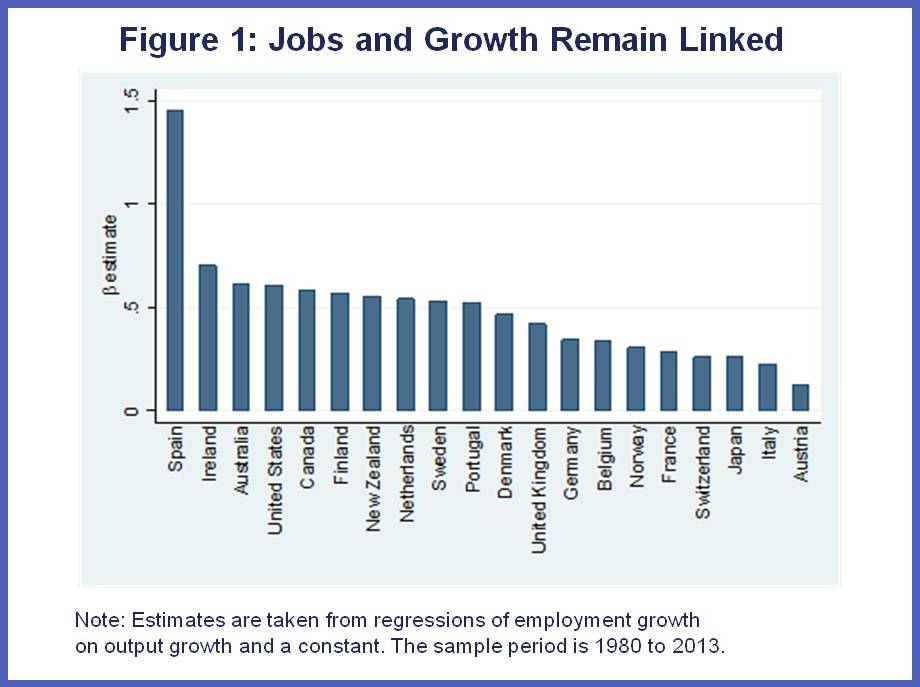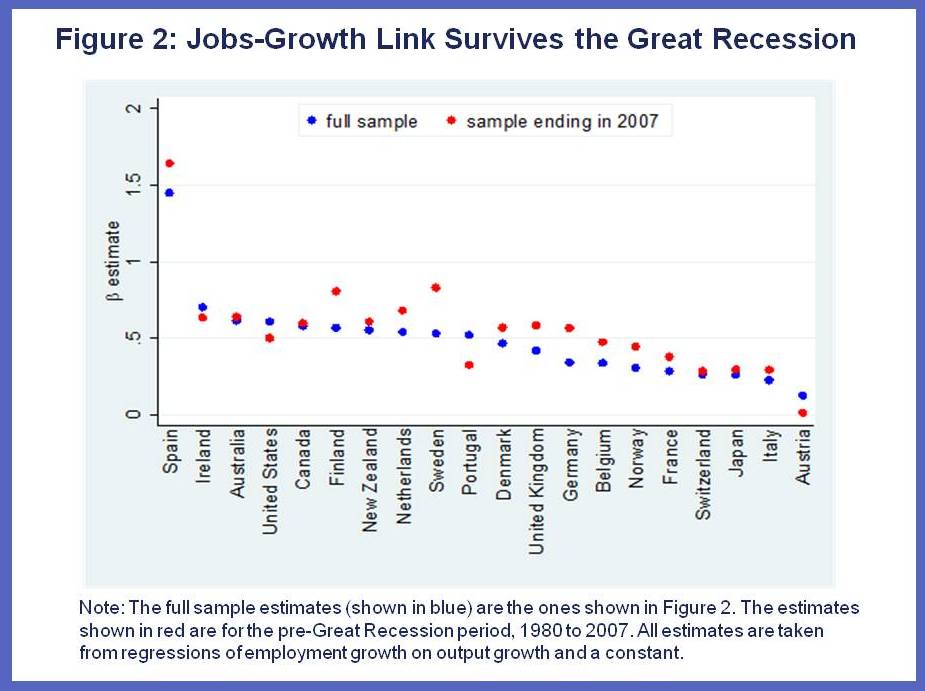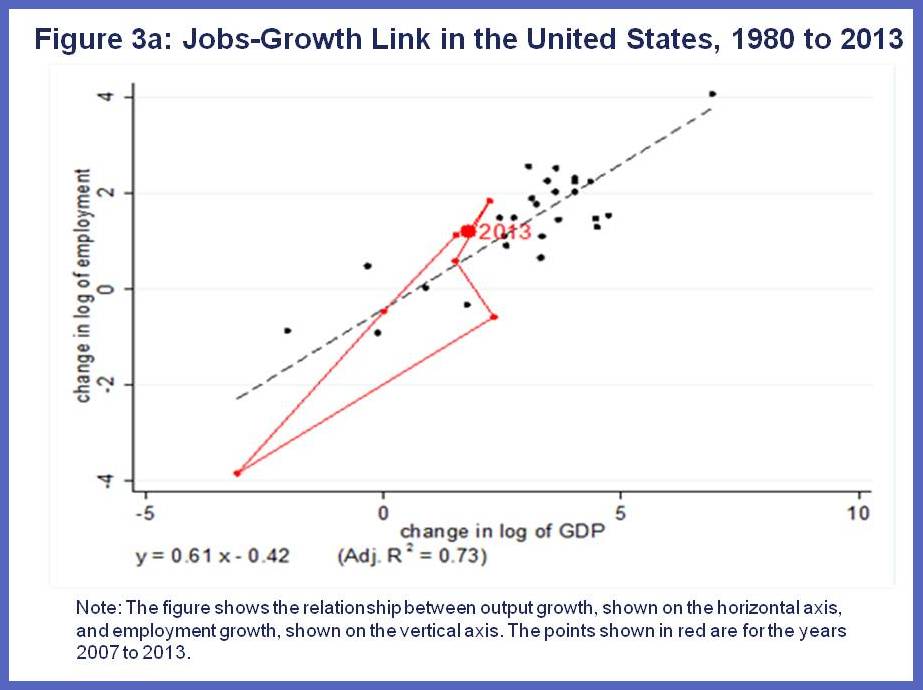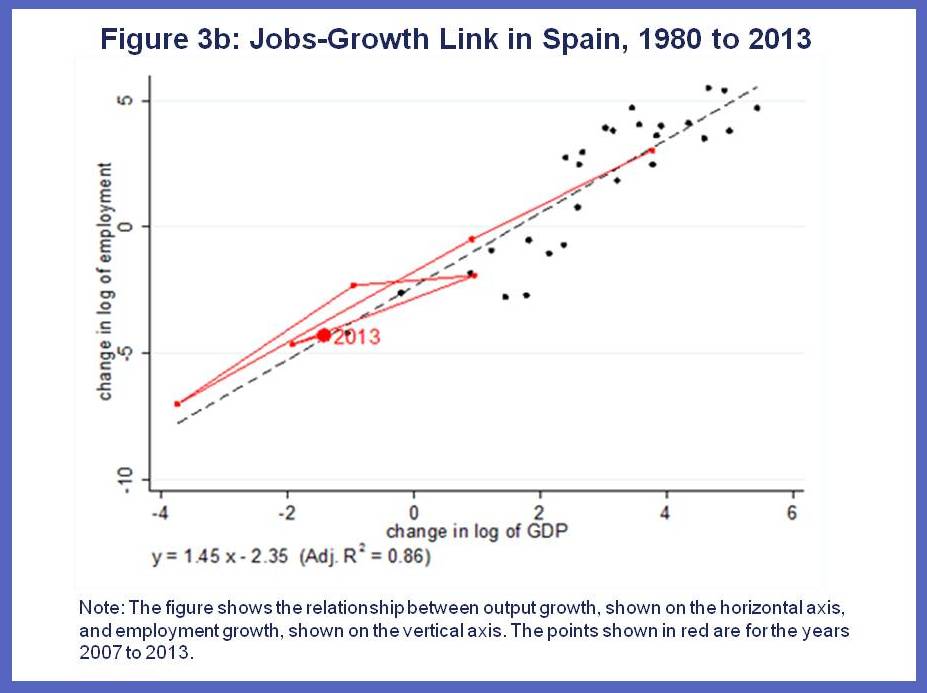(Version in Español)
Over 200 million people are unemployed around the globe today, over a fifth of them in advanced economies. Unemployment rates in these economies shot up at the onset of the Great Recession and, five years later, remain very high. Some argue that this is to be expected given that the economy remains well below trend and press for greater easing of macroeconomic policies (e.g. Krugman, 2011, Kocherlakota (2014)). Others suggest that the job losses, particularly in countries like Spain and Ireland, have been too large to be explained by developments in output, and may largely reflect structural problems in their labor markets. Even in the United States, where unemployment rates have fallen over the past year, there is concern that increasing numbers of people are dropping out of the labor force, thus decoupling jobs and growth.
Strong link between employment and growth
What does the evidence show? In new research, Laurence Ball, Daniel Leigh and I find that the link between output growth and employment growth holds strongly in most advanced economies. We find no evidence that this link—which goes by the wonkish name of Okun’s Law—broke down during 2008 to 2013, including in high unemployment countries like Ireland and Spain.
On average across the 20 advanced economies we study, a 1 percentage point increase in output growth leads to a ½ percentage point increase in employment growth (Figure 1). This link between jobs and growth, called the Okun coefficient, varies across countries, ranging from high values of 1.5 for Spain and 0.7 for Ireland to low values of 0.3 for Italy and 0.2 for Austria. The high value of Spain’s Okun coefficient reflects the greater use of temporary contracts there compared to other countries: this means that when times are good many new jobs are created but there is also a lot of job loss during recessions.
We find that Okun’s Law survived the stress test of the Great Recession: there is little evidence that the link between growth and jobs changed appreciably over the course of the Great Recession. This is evident from Figure 2, where the Okun’s coefficients for the full period 1980 to 2013 are essentially the same as what they were before the Great Recession.
Figure 3 shows tracks the relationship between employment and output growth for two countries in our sample, the United States and Spain. The trajectory of output and employment since 2007 is highlighted in red in the figures.
For the United States, Okun’s Law fits very well, that is, the relationship between output and employment growth is strong (Figure 3a). During the Great Recession, there was a year in which U.S. employment fell quite a bit more than expected, but the historical relationship was restored by 2013. (It is worth noting that a similar relationship for unemployment would indicate that U.S. unemployment today is about a percentage point lower than its historical relationship with output growth, consistent with the view of Erceg and Levin that people dropping out of the labor force could be accounting for some of the sharp drop in U.S. unemployment.)
In the case of Spain the jobs-growth link is very tight with little evidence that it broke down over the Great Recession; the trajectory shown in red remains close to the historical relationship (Figure 3b).
Course of policy action
Our evidence matters for the interpretation of employment movements and for policy. The alleged breakdown of the jobs-growth link is often used as support for the view that the problems in the labor market are structural in nature and would not be solved by policy responses aimed at bringing about a cyclical recovery. McKinsey (2011), for example, argues that Okun’s Law has broken down and that a return to full employment will thus require not just “healthy GDP growth [but also] major efforts in education, regulation, and even diplomacy.”
In contrast, our results suggest that, as IMF Managing Director Lagarde noted recently, “the most effective way of boosting jobs is to get growth going again … an additional percentage point of growth in the world’s advanced economies would lower unemployment there by about half of a percentage point, pulling over 4 million people back into jobs. So, in order to create jobs, we must lift economic growth. How can this be done? In the near term, there is no doubt that it will take smart monetary and fiscal policy to protect the recovery.”
Of course, the finding that Okun’s Law holds does not in itself completely determine the course of policy action; that requires, as Nobel-laureate Peter Diamond stated at the IMF’s annual research conference, also looking carefully at relationships such as the Beveridge Curve—the relationship between jobs and vacancies—and other indicators of mismatch in the labor market.
But the alleged breakdown of Okun’s Law is often a jumping-off point for arguing that structural reforms are needed to make a major dent in unemployment. Our results suggest that while there may be good reasons to recommend structural reforms to boost employment, proposing them in the belief that Okun’s Law has broken down should not be one of them.








